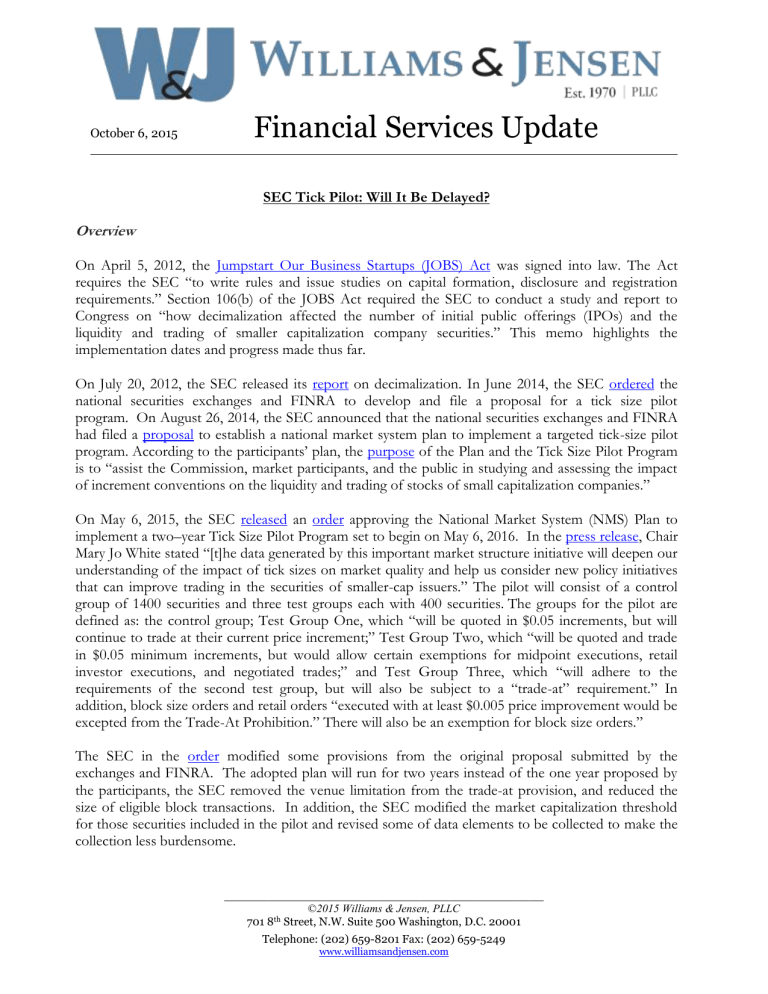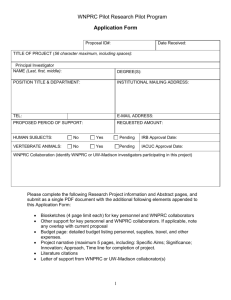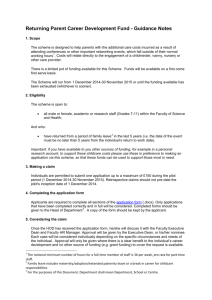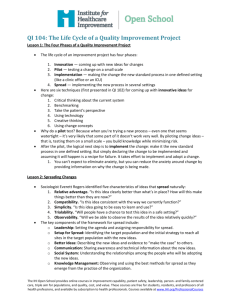Read... - Williams & Jensen

October 6, 2015
Financial Services Update
SEC Tick Pilot: Will It Be Delayed?
Overview
On April 5, 2012, the Jumpstart Our Business Startups (JOBS) Act was signed into law. The Act requires the SEC “to write rules and issue studies on capital formation, disclosure and registration requirements.” Section 106(b) of the JOBS Act required the SEC to conduct a study and report to
Congress on “how decimalization affected the number of initial public offerings (IPOs) and the liquidity and trading of smaller capitalization company securities.” This memo highlights the implementation dates and progress made thus far.
On July 20, 2012, the SEC released its report on decimalization. In June 2014, the SEC ordered the national securities exchanges and FINRA to develop and file a proposal for a tick size pilot program. On August 26, 2014, the SEC announced that the national securities exchanges and FINRA had filed a proposal to establish a national market system plan to implement a targeted tick-size pilot program. According to the participants’ plan, the purpose of the Plan and the Tick Size Pilot Program is to “assist the Commission, market participants, and the public in studying and assessing the impact of increment conventions on the liquidity and trading of stocks of small capitalization companies.”
On May 6, 2015, the SEC released an order approving the National Market System (NMS) Plan to implement a two–year Tick Size Pilot Program set to begin on May 6, 2016. In the press release , Chair
Mary Jo White stated “[t]he data generated by this important market structure initiative will deepen our understanding of the impact of tick sizes on market quality and help us consider new policy initiatives that can improve trading in the securities of smaller-cap issuers.” The pilot will consist of a control group of 1400 securities and three test groups each with 400 securities. The groups for the pilot are defined as: the control group; Test Group One, which “will be quoted in $0.05 increments, but will continue to trade at their current price increment;” Test Group Two, which “will be quoted and trade in $0.05 minimum increments, but would allow certain exemptions for midpoint executions, retail investor executions, and negotiated trades;” and Test Group Three, which “will adhere to the requirements of the second test group, but will also be subject to a “trade-at” requirement.” In addition, block size orders and retail orders “executed with at least $0.005 price improvement would be excepted from the Trade-At Prohibition.” There will also be an exemption for block size orders.”
The SEC in the order modified some provisions from the original proposal submitted by the exchanges and FINRA. The adopted plan will run for two years instead of the one year proposed by the participants, the SEC removed the venue limitation from the trade-at provision, and reduced the size of eligible block transactions. In addition, the SEC modified the market capitalization threshold for those securities included in the pilot and revised some of data elements to be collected to make the collection less burdensome.
____________________________________________
©
2015 Williams & Jensen, PLLC
701 8 th Street, N.W. Suite 500 Washington, D.C. 20001
Telephone: (202) 659-8201 Fax: (202) 659-5249 www.williamsandjensen.com
Williams & Jensen – Financial Services Update
October 6, 2015
Progress
The SEC order also includes a requirement that trading centers begin reporting “market quality data” six months prior to the start of the pilot and for six months following conclusion of the pilot. That means on November 6, 2015 trading centers will be required to begin reporting on this market quality data. The release states participants will collect: daily market quality statistics of orders by security, order type, original order size, hidden status, and coverage under Rule 605 of Regulation NMS; specified data regarding market orders and marketable limit orders; the daily number of registered market makers; and the daily market maker participation statistics.
A working group of four main exchanges and FINRA has been established to develop FAQs that will
“spell out the data collection requirements for Tick Size Pilot securities” and to gather input from non-
SROs on their needs. At a July 25 open call by the Securities Traders Association (STA), Brendon
Weiss, chairman of the SRO Tick Size Operating Committee, explained the FAQs should be “released in the next few weeks” but as yet none have been seen. According to Weiss, the data to be collected under the Tick Size Pilot program is “more extensive than current Rule 605 reporting requirements and covers entities that are not currently covered by Rule 605.” On October 2, at the STA Annual
Market Structure Conference Stephen Luparello (SEC Division of Trading and Markets) stated there are certain things which need to happen between now and November, including FAQs and rule filings.
He stated the expectation is that those will happen soon, but he suggested it seems unlikely that those will happen within the needed timeline. He stated the SEC will “not insist on a certain date if it will cause issues.”
Another requirement of the Pilot is that “no later than eighteen months after the start of the Pilot
Period” the participants are to provide the SEC a “joint assessment of the impact of the Pilot.” This assessment is also to be made publicly available. The participants are supposed to use the data generated during the first twelve months of the Pilot to determine the impact of said Pilot. The SEC order states that the assessment will include: “an assessment of the statistical and economic impact of an increase in the quoting increment on market quality, the number of Market Makers, Market Maker participation, Market Maker profits, and market transparency; an evaluation of whether any market capitalization, daily trading volume, or other thresholds can differentiate the results of the above assessments across stocks; an assessment of the statistical and economic impact of the above assessments for the incremental impact of a trading increment and for the joint effect of an increase in a quoting increment with the addition of a trading increment; as assessment of the statistical and economic impact of the above assessments for the incremental impact of a trade-at prohibition and for the joint effect of an increase in a quoting increment with the addition of a trading increment and trade-at prohibition; and an assessment of any other economic issues that the participants believe the
Commission should consider in any rulemaking that may follow the Pilot.”
Williams & Jensen, PLLC
701 8 th Street, N.W. Suite 500 Washington, D.C. 20001
Telephone: (202) 659-8201 Fax: (202) 659-5249 www.williamsandjensen.com
Page 2 of 3
Williams & Jensen – Financial Services Update
October 6, 2015
Timeline Summary
April 5, 2012
July 20, 2012
June 2014
May 6, 2018
August 26, 2014
JOBS Act passed
SEC released report on decimalization
SEC orders exchanges and FINRA to develop plan for a Tick Size Pilot
Exchanges and FINRA release plan for Tick Size Pilot
May 6, 2015 SEC approves Tick Size Pilot plan
November 6, 2015 Plan participants required to start reporting market quality data
May 6, 2016 Tick Size Pilot to begin
November 6, 2017 Participants required to provide joint assessment of the impact of the pilot
Scheduled end of the pilot
By: David E. Franasiak
Joel G. Oswald
Rebecca Konst
Williams & Jensen, PLLC
701 8 th Street, N.W. Suite 500 Washington, D.C. 20001
Telephone: (202) 659-8201 Fax: (202) 659-5249 www.williamsandjensen.com
Page 3 of 3







